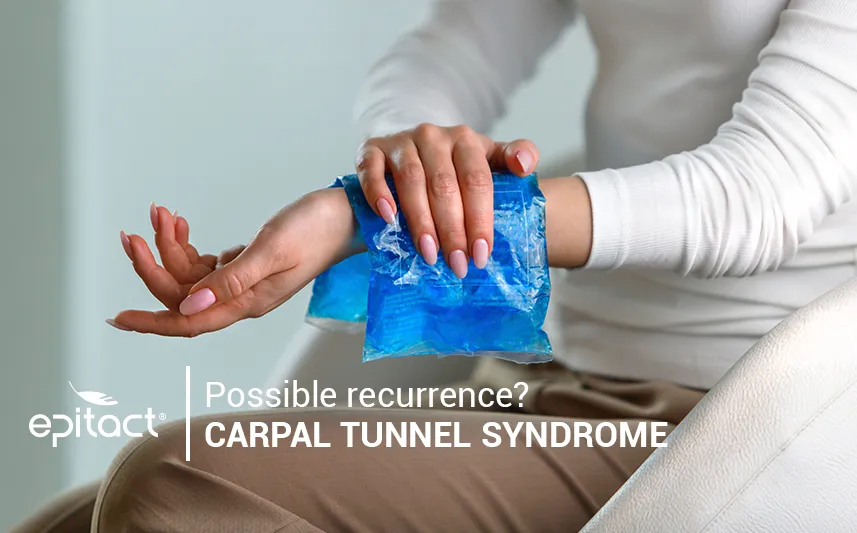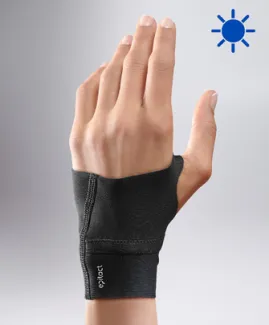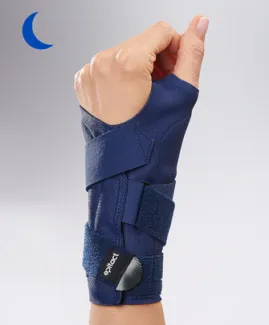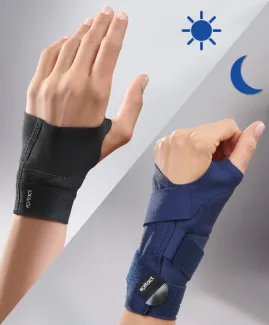
Most of the time, both non-surgical and surgical treatments put an end to the symptoms of carpal tunnel syndrome. However, you’re about to be operated and you’re wondering whether carpal tunnel can return after your surgery. Will tingling and numbness in the hands, thumb, index and middle fingers completely stop? Do you need to prepare for recurrent carpal tunnel syndrome?
There are three possible types of carpal tunnel recurrence; each of them corresponds to a specific treatment. Discover why you can get carpal tunnel twice and how to avoid it!
Is carpal tunnel syndrome permanent?
No, carpal tunnel is not permanent and many treatments are effective to cure it. They can be preventative, medical or surgical options, or a mix of them. However, carpal tunnel recurrence exists and the symptoms can last or reappear even years after surgery. So yes, you can get carpal tunnel syndrome twice, no matter which treatment you received.
Recurrence of carpal tunnel syndrome after wrist splinting
In the short term, immobilising the wrist can reduce the symptoms associated with carpal tunnel syndrome (CTS). In the long term, this option could overuse other joints like the elbow or shoulder. Indeed, since the brace limits wrist movements, the other joints tend to compensate for this lack of mobility and may weaken.
The immobilisation period must be brief. To avoid that carpal tunnel syndrome returns once the brace has been removed, carefulness should be constant. Gestures and postures should be corrected to preserve the joint and relieve the symptoms of carpal tunnel as much as possible.
In this case, wearing a brace during activities can help you be aware of these movements. EPITACT® has developed the CARP’ACTIV™ brace* based on proprioception. It means that your wrist remains mobile but you intuitively limit and correct traumatic micromovements.
Can carpal tunnel come back after injections?
Some studies(1) stressed the real benefits of corticosteroid injections in people with severe CTS. However, this improvement seems temporary: after one month, the benefits disappear. No difference was found between the group having received steroid injections and the group with placebo injections. In addition, 50% of patients treated with injections presented recurrence of carpal tunnel symptoms the next year.
It could be interesting to carry out other studies to compare the effects of injections with conservative treatments like splints or braces associated with non-steroidal anti-inflammatory drugs.
How can carpal tunnel return after surgery?
In 80% of cases, carpal tunnel release surgery is a success. Symptoms disappear after the surgical intervention.
But in 20% of patients, either the symptoms never completely disappear (persistent symptoms) or they reappear at least 3 months after the surgery (recurrent symptoms). Indeed, carpal tunnel can return after surgery in case of incomplete decompression (insufficient cutting of the carpal ligament).
Another surgical intervention is performed in 0.3% to 12% of cases of recurrent carpal tunnel syndrome.
Persistent symptoms
If you keep getting pins and needles in your hands, have paraesthesia (tingling) and pain, they are persistent symptoms of CTS. Several reasons can explain this:
- Section of the transverse carpal ligament is partial. There is still pressure on the median nerve. A second surgery will allow complete release of the nerve.
- Delay in the treatment of CTS leads to median nerve damages that are almost irreversible. To avoid this, it is important to consult as soon as the first symptoms appear.
- Inflammation of the synovial sheaths of the flexor tendons causes a swelling that increases pressure in the carpal tunnel and compresses the median nerve. A drug treatment will reduce the inflammation.
Identifying the cause of the persistent symptoms is necessary to take appropriate corrective actions. In some cases of carpal tunnel syndrome, however, it can be a diagnostic error.
Recurrent carpal tunnel syndrome symptoms
If the symptoms of carpal tunnel syndrome return after 3 months of calm, an electromyogram will confirm their recurrence.
In most cases, it happens when the median nerve has difficulties to slide during movements of the fingers, handl and wrist. This process is often caused by fibrosis (abnormal increase of fibrous tissue) around the nerve, which takes place during healing. This additional volume impedes its sliding during some specific movements and sometimes causes pain.
This fibrosis can be the result of a surgical gesture or from postoperative complications (infection, haematoma, etc.).
If fibrosis is not extended, another surgical procedure is possible but it is complicated and the results are variable. Most patients have sequelae.
Discover in the next article how to limit the risk that carpal tunnel returns after surgery. It gives you advice about the movements and gestures to avoid that aid the development or recurrence of carpal tunnel syndrome.
To conclude, it is true that you can get carpal tunnel twice. It can come back after surgery or affect your other hand. For this reason, the priority is to consult as soon as the first symptoms appear. You can also change your habits to improve the chances of success and avoid carpal tunnel to reoccur.
*CARP’ACTIV™ is a class I medical device that bears the CE marking under this regulation. Carefully read the instructions before use. Manufacturer: MILLET Innovation. 03/2020
For more details about this general and simplified approach, here is another source:
(1)Marshall S, Tardif G, Ashwoth N. Local corticosteroid injection for carpal tunnel syndrome. Cochrane Database Syst Rev 2007, Issue 2.
 Pharmacie
Pharmacie

